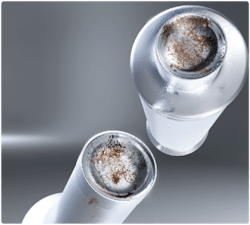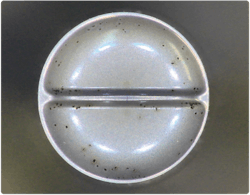Corrosion can severely affect tablet compression tooling if it is not addressed effectively. It can delay production, reduce efficiency and cause contamination problems.
Corrosion can be detected by the appearance of discoloration, etching or common red rust. The main cause of corrosion is acidic substances, which can include ingredients found within the formulation being compressed and even in the surrounding atmosphere. The iron particles in the metal tooling are exposed to oxygen and moisture in the form of humidity or vapor. When the steel is exposed to water, the iron particles are lost to the water’s acidic electrolytes. This means they oxidize the iron particles, which form corrosion on the punches and dies.
There are several reasons why corrosion can occur, and although challenging, it can be resolved with a combination of the correct steel, coating or treatment selection and proper maintenance procedures.
Atmospheric moisture
One of the principal causes of corrosion is excessive moisture and humidity. This is because corrosion often forms in areas where the liquid is present. Oxygen is found in the air we breathe and humid air carries water. The percentage of water vapor in the air varies based on temperature and can range from as low as 0.2% to up to 4% water vapor.
Excess humidity in the compression room, tool storage area or places where the drug formulation is stored prior to compaction can have a significant impact on corrosion forming on the tooling. It is therefore extremely important to control the environment in all areas of tablet production.
As we cannot remove oxygen from the air and tooling is made from steel, environmental factors should be in place to regulate the temperature and humidity and minimize moisture to prevent corrosion from forming on the punches and dies.
Formulation content
All formulations have very different characteristics with varying moisture content, which is often needed to help bind the tablet structure. However, too much water within the tablet can be a cause of corrosion and lead to other problems like sticking.
It is not just moisture content within the formulation that can lead to corrosion. Formulations containing corrosive elements such as chlorine, salts and acids will react with the tooling surfaces and result in oxidation. In addition, wash-in-place systems fitted to some modern tablet presses expose tooling to water and cleaning solutions. Post-compression cleaning procedures can also cause corrosion if not controlled appropriately. It is therefore important that tooling has the appropriate corrosion-resistant properties through the correct steel and coating selection.
Protecting against moisture
Optimizing the environment in which tablet compression and storage of tooling takes place can have a significant impact on preventing corrosion, but other solutions, including tooling material, coatings and maintenance, should also be considered.
Tool steel selection
Wear and degradation of tooling are inevitable in tablet manufacture. The repetitive cyclic action of compression will take its toll on tooling, particularly if they are not maintained. A substantial influence on tooling deterioration is the formulation being compressed. Some products can cause adverse effects on the punch tips — for example, certain granules are extremely hard and abrasive. These can scratch, wear and impregnate the steel surface. Other granulates can contain corrosive elements which react with the steel. This deterioration can lead to tableting defects like black spots, which are the result of corroded tooling and sticking where the granulation adheres to the punch tip face causing costly wastage, reduced yield and unwanted press downtime.
High-quality tooling should be able to offer long life and be anti-abrasive and wear-resistant. The appropriate choice of material will help to reduce the risk of damage to the punches and dies from the effects of abrasion, corrosion and impregnation of hard granules.
The correct steel is crucial to the successful performance of tablet compression tooling. There are several characteristics that should be addressed when selecting steel:
- Strength: Ability to withstand an applied stress without failure
- Corrosion resistance: Resistance to oxidizing, staining and discoloration
- Toughness: Resistance to chipping, cracking and punch tip breakage
- Abrasive wear resistance: Resistance to abrasive wear of punch tips and die bores
- Adhesive wear resistance: Resistance to adhesive wear, galling and welding
- Hardness: Resistance to impregnation from hard, sharp granules
- Compressive strength: Resistance to die bore ringing and plastic deformation of punch tip edges
- Fatigue resistance: Progressive and localized structural damage that occurs when a material is subject to cyclic loading
If the tooling being used is prone to corrosion due to environmental effects or because of the characteristics of the formulation, a specially selected tool steel is a good option. Specialized martensitic stainless steels with high chromium content should be used as they have a higher resistance to oxidization, staining and discoloration of the tablet tooling.
Corrosion on tablet tooling can delay production, reduce efficiency and cause contamination problems.
Coatings and treatments
The correct tool steel choice is essential in the prevention of corrosion, but so are the tool coating and treatments.
Tool coating selection can have a fundamental impact on production. When used in conjunction with high-quality tooling steel, tool coatings are a great method of solving tablet production problems. They allow for better tableting efficiency and output by reducing the requirement for tools to be taken out of production for additional cleaning and maintenance work to remove problematic residue, which, if left untreated, may cause potential production issues, such as corrosion, sticking and picking.
Traditionally, electro-plated hard chromium was the most popular coating used within the tablet tooling industry, but it has many disadvantages. When hard chromium is applied to tooling, a certain amount of hydrogen penetrates the substrate, which can decrease the steel’s working load by up to 20%. To counter this effect, the plated tools undergo a baking process known as de-embrittlement that reduces but does not eliminate the unwanted characteristic. It is also subject to micro-cracks which can develop during the plating process when the internal stress exceeds the tensile strength of the chromium. These micro-cracks are problematic because they provide a porous route to the substrate that will allow granule or cleaning solutions to attack the steel beneath.
Specialized coatings have been developed which are chromium-rich and applied via an advanced Physical Vapor Deposition (PVD) process. The PVD process creates a very smooth dense anti-stick coating. This process incurs none of the drawbacks associated with applying hard chrome.
When it comes to choosing a tool coating, understanding the product being compressed is crucial. For example, if the formulation has a high number of corrosive elements like salts and acids, it will eventually react with the steel and result in oxidation and other forms of decay. In these instances, an appropriate corrosion-resistant coating should be selected, for example, those containing chromium or chromium nitride.
Tool maintenance
Incorrect tool maintenance procedures including the handling, cleaning, polishing and storage of punches and dies can have a huge impact on tablet production. All these processes will expose the tooling to materials and environments where there is a risk of oxidization. It is therefore important that tried and tested maintenance practices are in place to prolong tool life.
The purpose of regular tablet tooling maintenance is simple: to minimize compression problems and ensure that it operates at its highest functionality. Ensuring tablet punches and dies are kept in optimum condition to produce high-quality tablets is critical for productivity and overall equipment effectiveness (OEE). Frequent audits of procedures should be planned to maintain and protect against corrosion issues. The cost of poor tool care and maintenance not only results in additional unnecessary tool purchases but also in production problems that could have been avoided.
If tooling is cleaned without corrosion inhibitor or insufficiently dried, corrosion can take place.
The appropriate cleaning procedures are essential when looking to prevent corrosion. It will remove granules from the punch and help to avoid product contamination and potential production issues such as sticking and picking caused by old products adhering to the surface of the punch tip.
Post-cleaning is also the ideal time to accurately assess the condition of the tooling. If punches are not clean, any visual assessment of the punch tips and die bores can be affected. This would mean that problems like wear, damage or corrosion are missed.
When tooling is removed from the tablet press, it must be thoroughly cleaned to remove any oil or product residue, particularly from difficult-to-reach areas such as embossing and keyways. One of the most reliable cleaning methods is ultrasonic cleaning. Ultrasonic baths allow for consistent cleaning results, reduced processing and operator time, and reduced risk of tablet contamination. Importantly, ultrasonic cleaning allows for the whole punch to be cleaned including in and around the embossing. It is essential, however, that the process does not cause corrosion of the tooling material, therefore a corrosion inhibitor should be added to the cleaning cycle at a defined concentration. This will form an oxide film on the surface of the metal, passivating the steel and protecting it from corrosion.
It is also important to remember to thoroughly dry tooling after cleaning to ensure there is no residue of cleaning fluids left on the tooling surface which could cause corrosion.
Handling of the tooling can be another cause for concern. It is always recommended to use gloves when picking up the tooling. This is because acids and moisture are present in human hands and can cause and accelerate corrosion on tooling. It is not unheard of for a rusty fingerprint to be left behind! Ensuring gloves are worn at all times and following proper maintenance procedures and techniques will prevent this from happening.
Adopting a simple structured tooling maintenance process is essential to obtain the maximum life from punches and dies. By applying these recommended best practices problems like corrosion will be prevented and tool life will be extended.
Keep a check on corrosion
The cost of corrosion due to not understanding the characteristics of the formulation and poor tool care and storage not only results in additional unnecessary tool purchases but also in production problems that could have been avoided. It is important to address corrosion at the root cause so tablet production is not affected.
Know the granule being compressed, does it contain hard and abrasive granules or ingredients that contain chlorine, salts and acids? Is there high moisture content in the air where compression and storage take place? If the answer is ‘yes,’ it is important to protect tooling so corrosion does not take hold.
Through the use of the correct tool steel and corrosion-resistant coatings, the durability and efficiency of tablet tooling will increase. Add to this effective maintenance and tool care procedures and pharmaceutical manufacturers can obtain the maximum life from tablet punches and dies.




